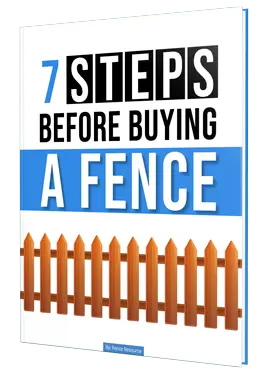What is Aluminum Fence?
Aluminum fence is an ornamental type of fence that looks like wrought iron fence. There are three components that make an aluminum fence. Pickets, rails and posts.
Pickets are the thin vertical metal pieces. Rails are the long horizontal pieces. Most aluminum fences have 3 rails. However, 2 rail styles are popular around swimming pools. Taller fences over 6′ tall can have 4 rails. These two components combine to form a section or panel.
The posts are the larger vertical supports between the sections. Today most of the fence installed that looks like wrought iron fence is actually made from aluminum. There are reasons for that however.
So let’s take a look at some reason you would choose to go with an aluminum fence.
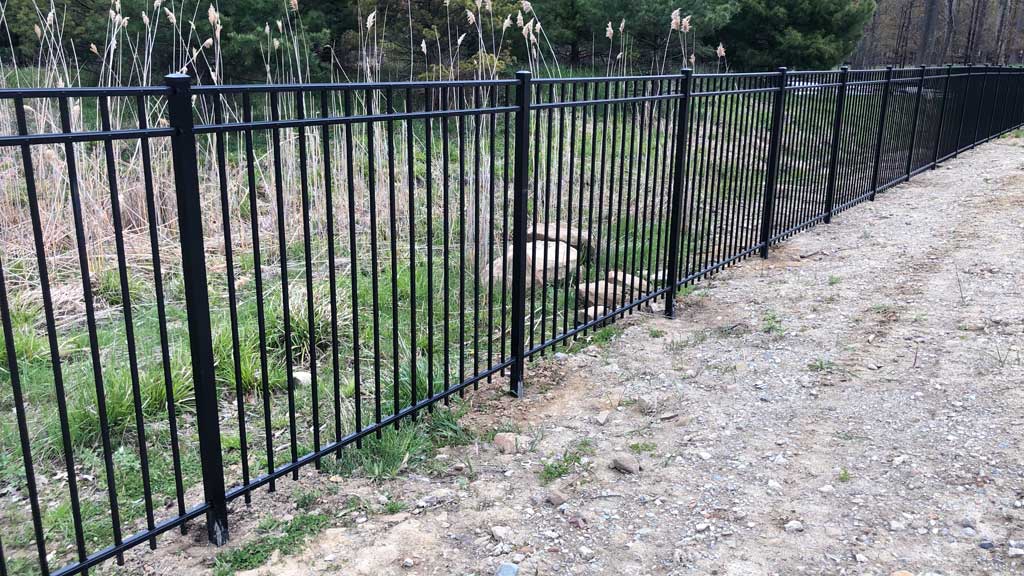
Why Choose Aluminum Over Iron Fence?
Both aluminum and wrought iron fences have their place in the market. Both are ornamental and ornate by design.
Iron is more sturdy and better when security is a primary factor. However, there are many reasons one would to choose to purchase an aluminum fence over an iron fence.
Let’s take a closer look at some of the advantages when compared to wrought iron fence.
Aluminum Fence Doesn’t Rust
Let’s face it. We all want to buy a fence once and never worry about it again. Aluminum fence fills that need. Aluminum cannot rust like steel or iron can.
This reason alone is why more people choose aluminum fence over all other types of metal fences. Not being able to rust is a huge advantage.
In costal regions, salt spray is the number one reason a metal fence will rust. Many aluminum fence manufactures actually test their finishes with a salt spray test.
Rated in hours, this test assures that the finish will stand up to the harshest of conditions. As a result, providing even greater resilience to normal whether conditions.
Northern climates have salt spray problems too. But in a different way. Salt is needed to melt ice and snow from roads. Cars drive on the wet roads and the tires lift the salt spray into the air, potentially landed on the fence.
The finish on aluminum fence is strong enough to combat this alone. However, another problem with metal fence located near roadways occurs that compounds the problem.
All summer long, little pebbles kick up from tires and hit the fence. These little pings from stones chip or crack the coating or paint on metal fences. Then winter comes allowing salt spray to come into contact with bare metal.
Aluminum will not be effected. However, an iron fence will not last long under these situations. Rusting out quickly and requiring constant maintenance or replacement.
Lifetime Warranty
Most aluminum fence manufacturers offer lifetime warranties on their products. Another reason why consumers choose aluminum over steel or iron.
We already know it can’t rust. Furthermore, manufactures use powder coating or baked on enamels for finishes. These provide ultra strong coatings that protect the aluminum.
Another advantage of aluminum is that it stays straight and true. So there is no need to worry about warping or twisting like some wood fences. They never need to be sealed to prevent water damage either.
Aluminum fences are the most maintenance free fences available. Combine that with a lifetime warranty and it’s no wonder they are so popular.
Aluminum is Less Expensive Than Steel
Price is another advantage aluminum fence has over steel or iron fence. True wrought iron fence is still hand built by custom craftsman.
Welding solid pieces of steel together one piece at a time. While they are capable of producing some extraordinary designs, the man hours in labor accumulate. Those labor costs drive the price up substantially.
Aluminum fence is made from hollow aluminum tubing. Manufactures have automated many of the processes used for constructing the fence panels.
As a result, the volume of product produced can’t be touched by a custom iron shop. Therefore, the cost of a section is greatly reduced.
Aluminum Fence is Rackable
Screws used to assemble the sections allow the sections to rake. Known as “rackable”, this allows a section of fence to follow change in grade.
You may think your yard is flat, but once you start running string lines you will find out just how much it changes grade.
Wrought iron fence is welded together with the rails and pickets perpendicular to each other. As a result, the section must hang level between each post.
Sections must be stepped up or down when changes in grade occur. This stepping process leaves triangular gaps under the fence. These gaps are not conducive for keeping in pets or children.
They also violate pool codes when those gaps become larger than 4″. Rackable aluminum fence sections allow the fence to follow grade, minimizing the amount of space between the ground and bottom of fence.
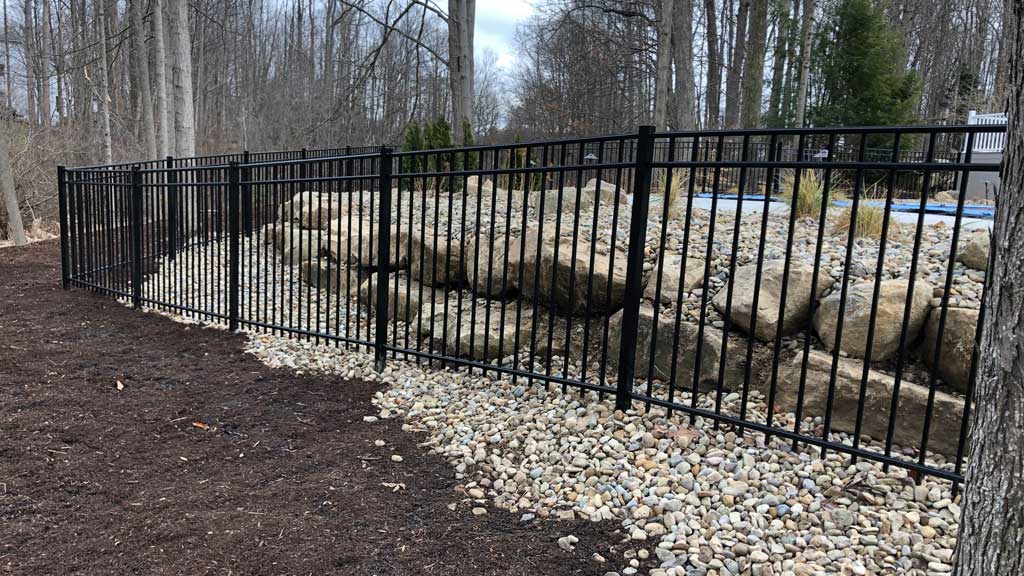
Uses For Aluminum Fence
People use aluminum fence in many ways. The most popular use is around swimming pools. It provides a safe secure perimeter while allowing visual transparency to keep the pool in plain view.
Many styles meet Boca Pool Codes which relate to the height of the fence, the distance between the pickets, and the distance between the horizontal rails.
Fencing in dogs is another popular use. But its use doesn’t stop there. It is also commonly found along parking lots, at shopping malls and at gas stations.
Commercial and Industrial businesses choose aluminum fence because it provides great security. The distance between rails on taller heights are almost impossible to climb.
Because aluminum fence offers an open and transparent design, it does not provide hiding places for would be burglars or criminals.
Find out what the Best Dog Fencing is for Every Type of Dog
Aluminum Fence Styles
There are two primary styles that aluminum fence is offered in. Flat top and spear point. Both are very popular depending on the application and use of the fence.
One of the best things for fence salesmen is that with most manufactures, the style of fence does not effect the price. This makes it easy for the consumer to get a fence quote without committing to a specific style.
Let’s take a closer look at each style and discuss where one or the other would best be used.
Flat Top Aluminum Fence
Just as the name states, flat top aluminum fence is flat on top. The highest rail is installed flush at the top of the each section. Most manufactures offer slight variations on 3 rail models.
Flat top aluminum fence is great for swimming pools. The flat top provides a place to hang beach towels and rafts. It is also very safe when compared to spear points. Especially if jumped for any reason.
Bars and restaurants use flat top style aluminum fence around their patios and outdoor dining areas. Although flat rails can promote sitting, they are much safer if an accident should happen, especially when alcohol comes into play.
Daycare facilities and playgrounds are also common places to find aluminum fence with a flat top. As discussed earlier, it lends itself to be safer overall wherever mischief or shenanigans seem to happen.
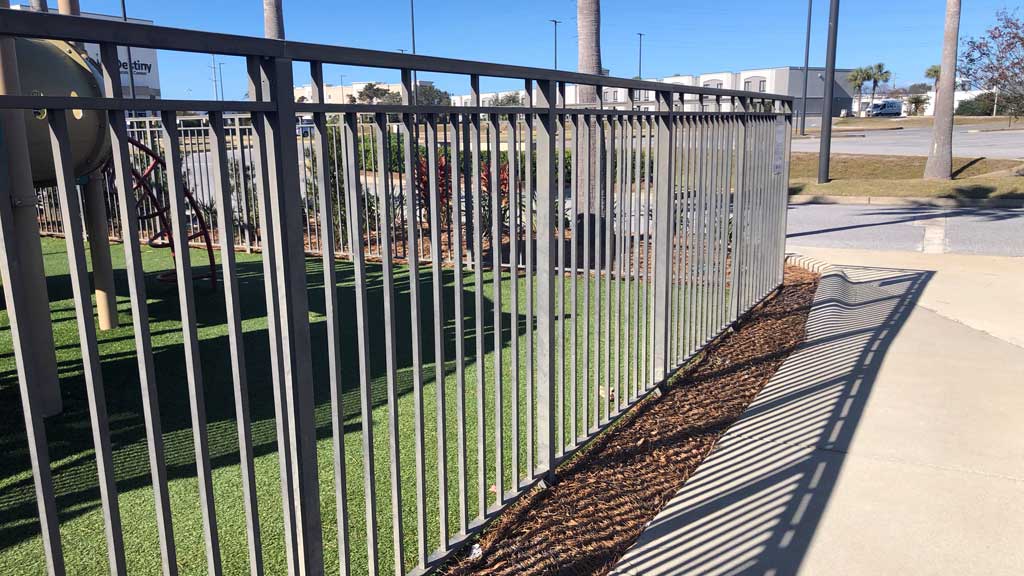
Spear Point Aluminum Fence
When you think of wrought iron fence, you probably invision some kind of spear point sticking out above the rail. Aluminum fence in no different. The two most popular options for spear points are straight and staggered.
Straight spear point fence has all of the pickets installed at the same height. This provides a uniform look across the top of the section.
Staggered spear points alternate from high to low. Both styles make it hard to climb over. Spear point aluminum fences are great for higher security situations.
For maximum security there are styles that have the points turned facing outward. This makes climbing the fence nearly impossible.
Cemeteries are another common place to find spear points on aluminum fence.
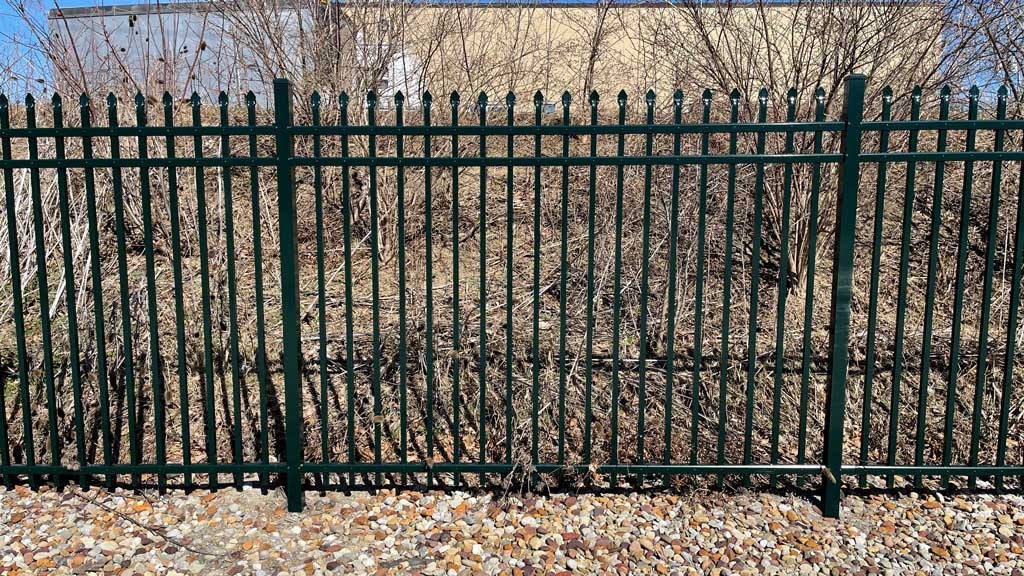
Aluminum Fence Add-ons and Accessories
We just learned about the two most popular styles of aluminum fence. Now let’s take a look at all of the extra options there are to customize your aluminum fence.
Manufactures offer consumers finials, rings, ball caps, scrolls, scalloped and arched sections, and puppy or doggy panels as add-ons.
All these extras can increase the price of your fence quickly. So proceed with caution!!!
Puppy Picket or Panels
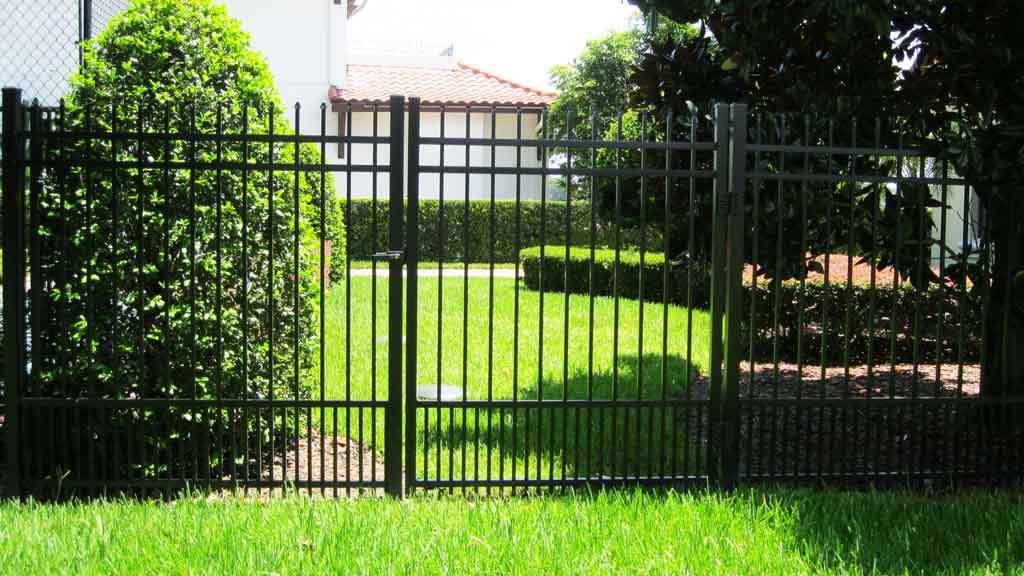
Every fence and railing codes states you cannot have a space between pickets larger than 4 inches. So aluminum fence manufacturers push the limits at 3-7/8″ space for the normal spacing.
But what if you have a small dog or a puppy? Puppy picket or panels are an option to keep small dogs secure. Normally they have twice as many pickets for a 1-1/2″spacing, but only up tp 18″ tall.
Considered tall enough to keep in puppies and other small dogs. This option also adds an extra rail to the fence section.
Prices increase substantially for this option. Most consumers don’t go this rout even if they have a puppy.
You don’t leave puppies outside on their own without supervision. So by the time you do leave them on their own, most are large enough they can’t squeeze through the normal spacing of a section.
Concave or Convex Sections
Concave and Convex sections change height over the span of each section. Also known as scalloped and arched, these sections have a radius look to them.
Most manufacturers offer a 6″ change in height over the length of the radius. Therefore, if you have a 48″ tall section with a concave scallop, it will be 42″ in the center of the section.
One thing to consider when choosing concave and convex sections is the layout of the fence. Most sections of aluminum fence are 6′ wide. If your layout has cut sections, this will change the look.
If all of your sections are full length and then a 2′ wide cut section is required, the scallop or arch will not look proportionate to the rest of the fence. It’s a good idea to keep this in mind when laying out your fence.
Rings, Finials, and Scrolls
Rings
If you’re really looking for that ornate look and feel, adding rings, finials or scrolls will do the job. Rings get mounted between the upper 2 rails of a 3 rail fence section.
There are two ways rings attach to a section. The first way is to screw them on. This process is completed after the fence is installed. The second way is to have them manufactured directly into the panel.
There is one drawback to adding rings. They prevent your sections of fence from racking. Sections with Rings will have to hang level.
Finials
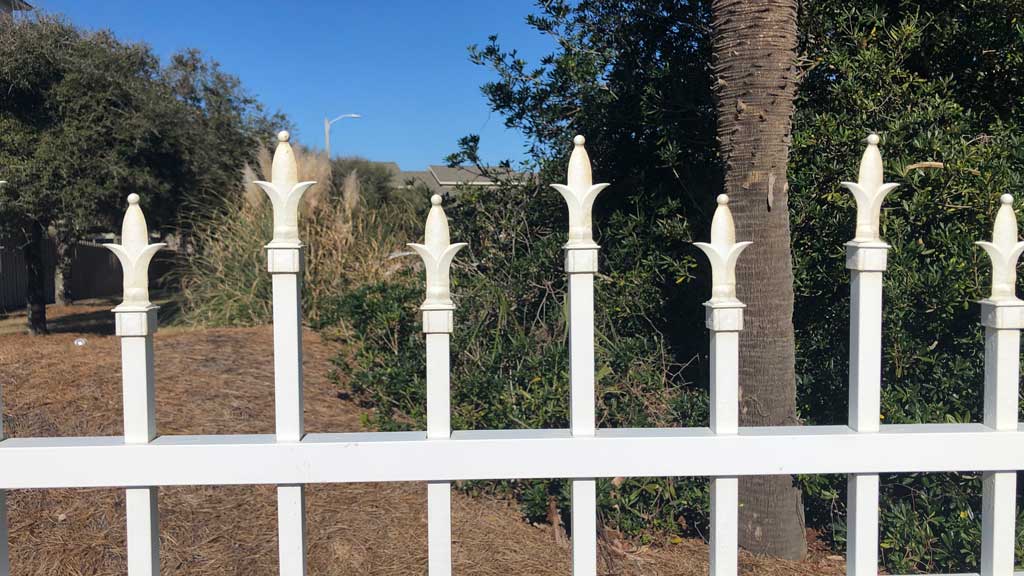
Finials are the little accent caps that mount on top of the pickets. The three most common types are a quad flare, triad, and fleur-de-lis.
The quad flare finial looks like a four side arrowhead with a small ball on the top. Triad finials resemble the boy have a three pointed protrusions. One straight up and the two outside having an outward curve.
The fleur-de-lis finial looks like the 3 pointed triad, but is much more ornate. Finials really give an aluminum fence a wrought iron look. However, they can increase the price of your aluminum fence drastically.
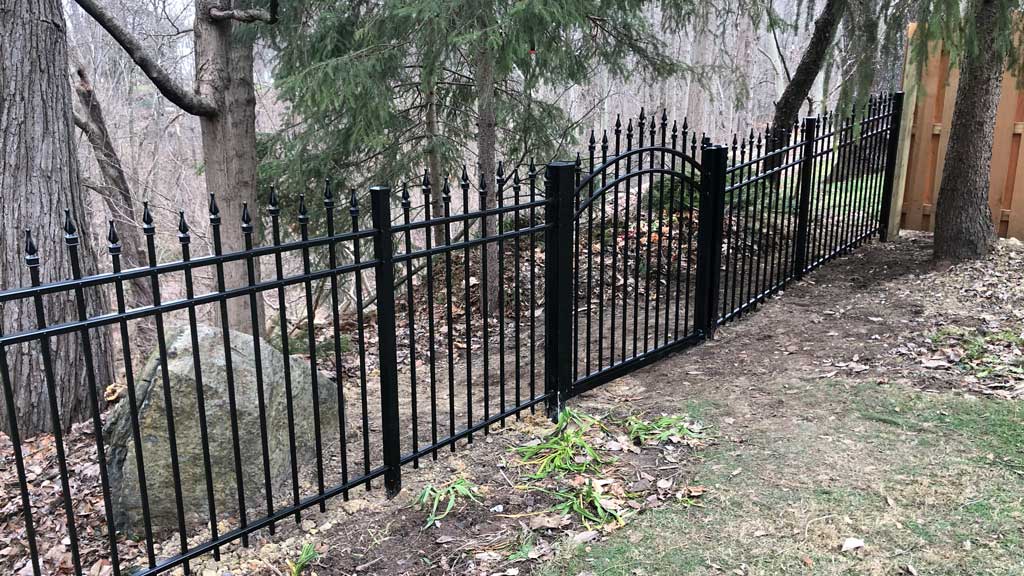
Scrolls
Scrolls are ornate attachments, sometimes with floral designs, that you can add to your fence. They come in various shapes in sizes.
Most scrolls fit overtop of one picket and fill the spaces to the left and right. Screwed into the picket, they can be added after the fence is installed.
Sometime, people choose a different color for the scrolls in order for them to stand out more. It is not common to have scrolls on every picket like rings. Normally just a few per section or on a gate is all you would want.
Aluminum Gates
Aluminum gates come in every size and configuration imaginable. There are two main categories of gates. Single or man gates, and double gates.
Double gates combine two single gates to cover larger openings in the fence. The location and number of gates is up to you. You’ll need at least one to access your fenced in area.
Think about the future when planning for gates. Will you be doing a future project that will require access of larger machinery like a bobcat or backhoe? Will a landscaper be mowing the grass? If so, you might need a larger gate for their commercial lawn mowers.
Let’s take a look at the each gate option and discuss some of their uses.
Man Gates or Walk Gates
Man gates and walk gates are the same. Consisting of one single gate panel called a gate leaf. Man gates are great for normal day to day foot traffic.
For our customers, I always go with a 48″ wide gate unless there is a reason to go smaller or larger. Sometimes space will be tight, so a 36″ wide gate would work better.
Other customers may have a riding lawnmower that has a 42″ cutting deck and want ample room to drive through. So a 60″ wide gate would work better in this situation.
If you are unsure, always error on a larger width gate.
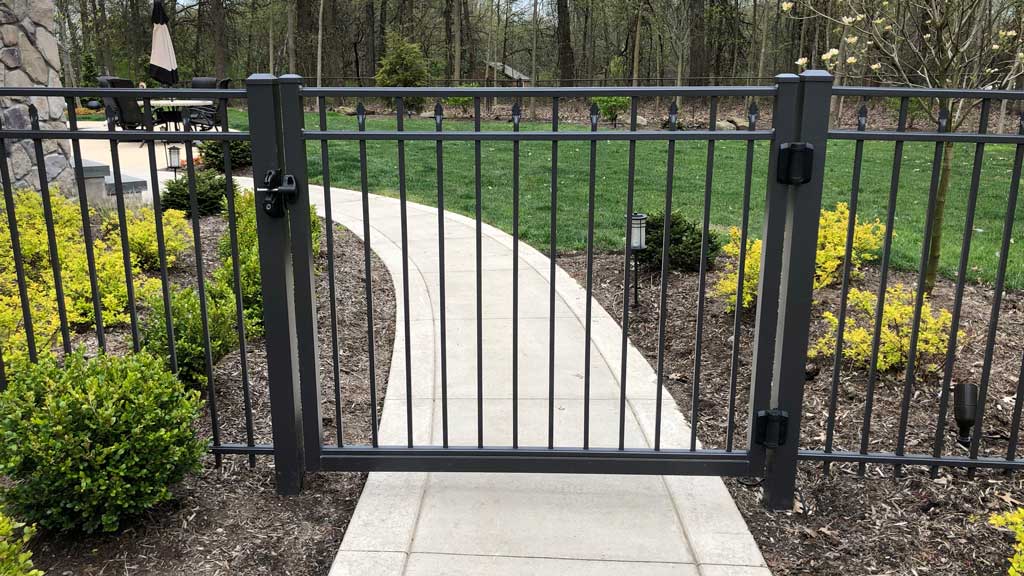
Double Gates
Double gates are nothing more than two man gates added together. Used when larger openings are needed. This could be because you are crossing a driveway or you plan on accessing your backyard with a truck periodically.
A drop rod will hold one of the leafs stationary. As result, you can use one half of the double gate like a man gate most of the time.
When more access is needed, the drop rod is lifted out of the ground allowing the second gate leaf to swing freely.
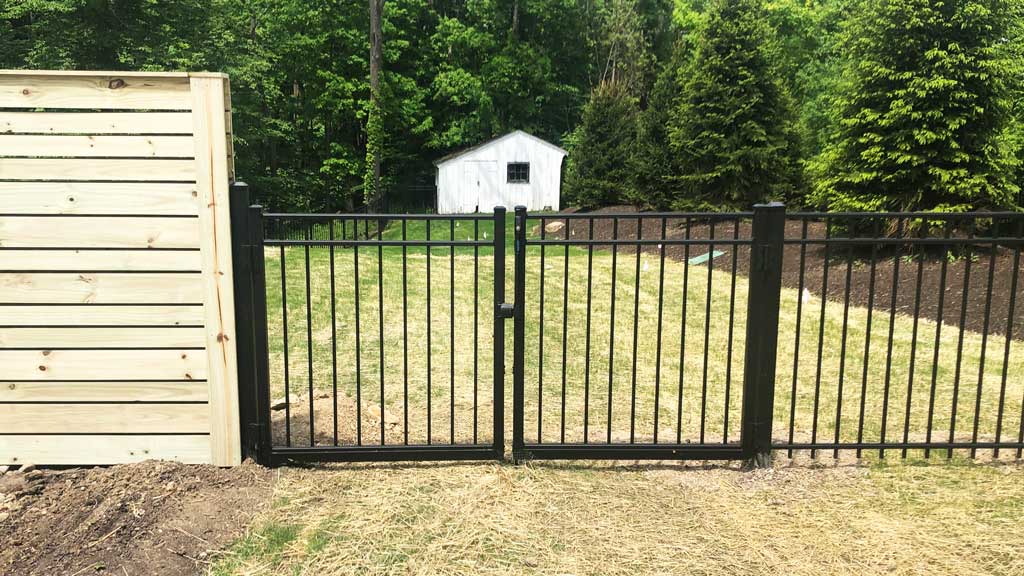
Estate Gates
Estate gates are constructed from heavier materials than normal gates. This allows them cover even larger openings. They can be one single leaf or double.
Estate gates are commonly used for driveway entrances. Many times they are automated with electric gate operators to open and close them automatically.
Estate gates come in a variety of configurations. Many aluminum fence manufactures will custom build them to your specifications.
Estate gates can really make a statement at your home or place of business. Usually more ornate than standard gates, becoming a focal point for all to see.
Aluminum Cantilever Gates
Cantilever gates are a type of rolling gate that slide from one side of the fence out across an opening. Often used when space for a swinging gate is not sufficient.
A cantilever gate rolls parallel to the fence line taking up little room. Because of their design, aluminum cantilever gates can cover larger spans than estate gates.
Many manufactures can accommodate an opening of up to 34′ wide with a single gate. Cantilever gates also work better in climates with heavy snow. Because they don’t require large swooping areas to open, they preform better in locations that get snow accumulation.
They are also less problematic when automating. Cantilever gates also perform better in high traffic areas like private parking lots or apartment complexes.
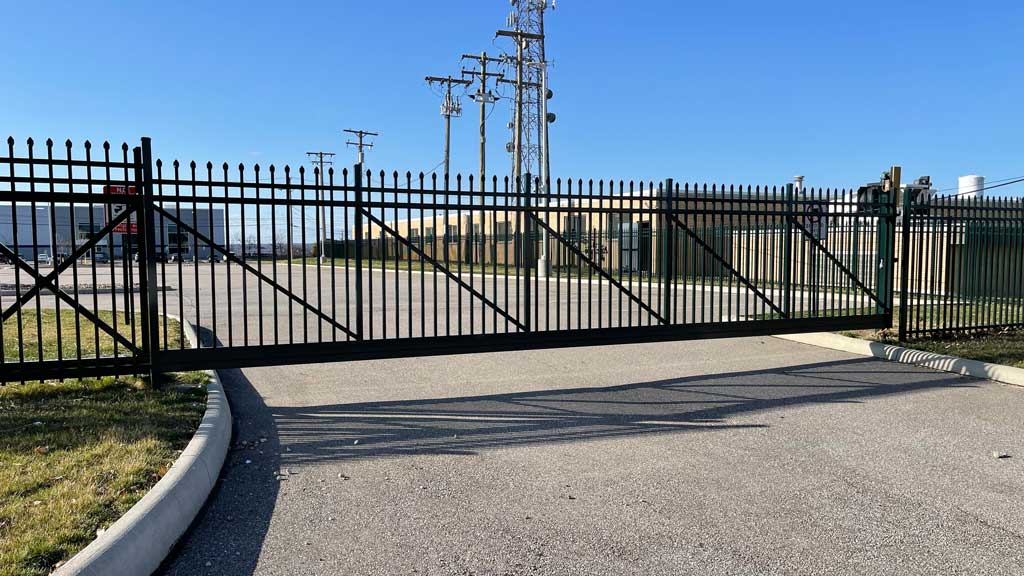
Aluminum Gate Options
Aluminum gates have the same options as aluminum fence. Arches or scallops are popular additions for gates. Rings and scrolls are too.
Estate gates often see initials of the homeowner incorporated into them. Gate operator rails are added for automated gates.
Gates without any options will match the style of fence you choose. Blending in with the rest of the fence. However, if you’d like your gate to stand out, you have that option!
What Color Does Aluminum Fence Come In?
When you think of wrought iron fence, you think of the color black, right? However, most manufactures offer many more colors.
Bronze, White, Grey, Beige and Green are normally standard options for color. Just like style, colors do not normally effect the price of the fence. And if color choices weren’t enough, some manufactures even offer matte versions and hammertone versions for their fence colors.
Black is the classic color for ornamental fence and the most popular for aluminum fence. But dark bonze colors are taking a close second to black.
A little less contrast than black, dark bronze doesn’t catch the eye as much and blends in better against wooded areas or landscapes beds. It also matches many of the earth tone colors builders are using in todays housing market.
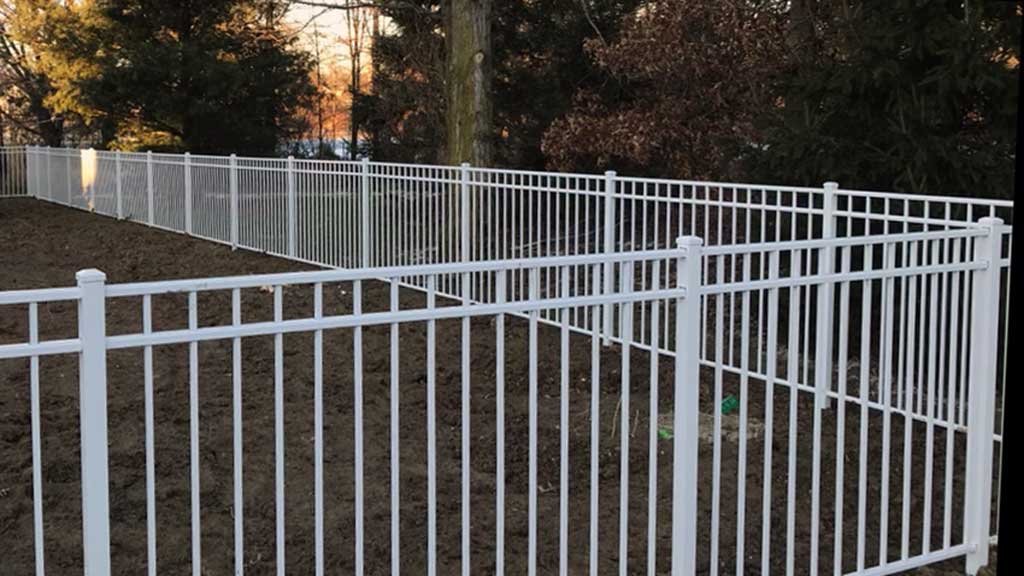
Aluminum Fence Grades
There are more grades of aluminum fence than there should be. Some manufactures can have 5 or 6 different grades. However, there are three aluminum fence grades every manufacture provides.
Residential, commercial, and industrial grade. For the sake of this article, these are the three we will focus on. Discussing the exact specifications of each grade would be impossible.
Each manufacturer tweaks the size of the their rail or picket slightly. So for exact specifications, please visit the manufactures website.
Residential Grade Aluminum Fence
Residential grade aluminum fence is the most common grade. Used for backyards and swimming pools all over the world. As well as keeping children and pets secure.
Having adequate strength for most residential applications. Offered in the most colors and style options, residential aluminum fence will add class and style to your property.
Some homeowners associations only allow aluminum fences as a requirement.
Commercial Grade Aluminum Fence
Restaurants and bars use commercial grade aluminum fence for outdoor patios and courtyards. Swimming pools found at country clubs and apartment complexes also use commercial grade fence.
Sometimes on high end residential projects people use commercial grade fence. The rails and pickets will have larger dimensions compared to residential grade.
Increasing the wall thickness also gives commercial grade fence extra strength.
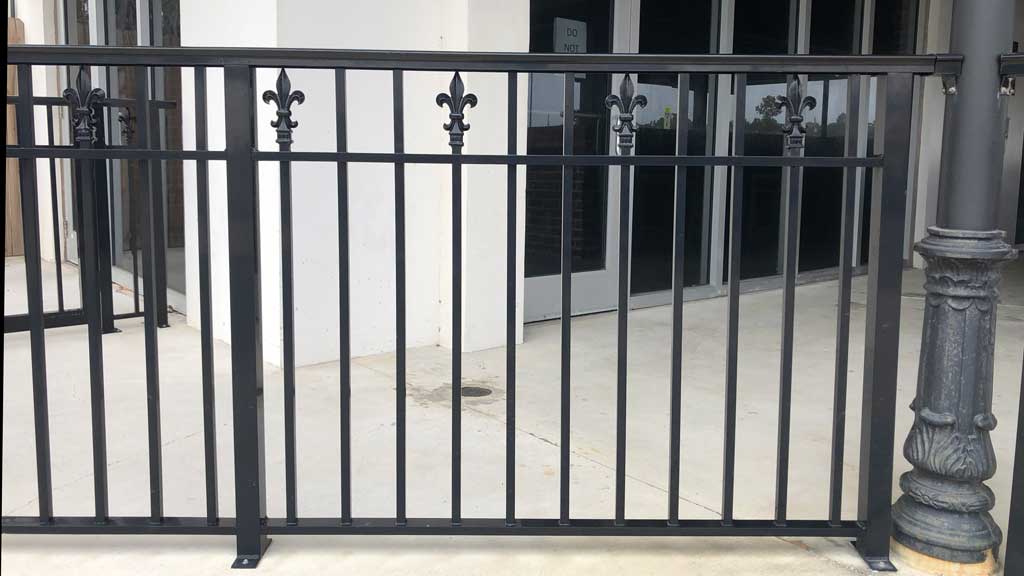
Industrial Grade Aluminum Fence
Industrial grade aluminum fence is even heavier. Used where strength and security is most important. Common applications would be for large businesses, public pools, and even amusement parks.
Industrial grade aluminum fence makes the statement of strength and security. 6′ tall and taller are common heights for industrial grade applications.
Industrial grade aluminum fence comes in lower heights too. Often used for hand railing.
What About the Posts?
Yes, the posts for aluminum fence also come in different sizes and grades. Aluminum fence posts start at 2″ square and can go up tp 6″ square, supporting the heaviest of gates.
The wall thickness of each post also determines how sturdy the fence will be. Gate posts should always be the heaviest posts. Don’t skimp here.
The gate is the part of the fence that gets the most abuse. Having sturdy gate posts prevent issues at later dates of gates not swinging or latching correctly.
Spend the extra money and get heavier gate posts. We don’t use anything smaller than 3″ square for gate posts. Even on residential gates.
What Heights Does Aluminum Fence Come In?
Depending on grade, aluminum fence can come in as short as 3′ tall and go all the way up to 8′ tall. 4′ tall is the most popular height for residential installs.
Some swimming pool codes may require 54″ to comply. Industrial grade ornamental fences are usually 6′ to 8′ tall.
Because aluminum fence is so transparent, unless extra height is needed for security or to keep in an athletic dog, it doesn’t make sense to pay for a taller height than you need. It will not provide any privacy or screening.
If privacy is the goal, there are aluminum privacy fences. However, another fence material will be your best bet.
Standard heights from most manufactures are 36″, 42″, 48″, 54″, 60″, 72″, 84″ and 96″. Custom heights are available. However, setup charges will apply.
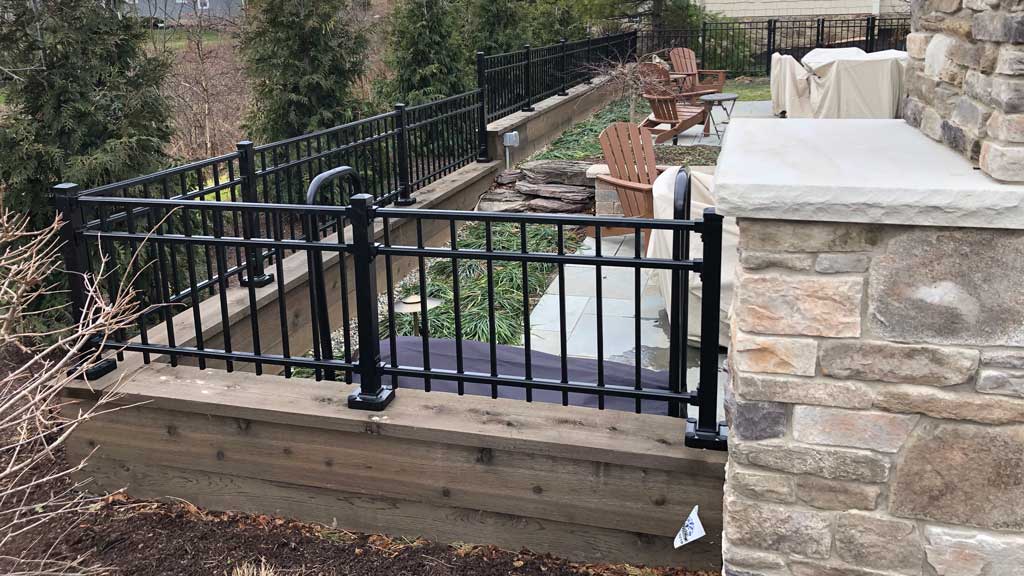
Aluminum Fence Maintenance
By far, aluminum fence has the least amount of maintenace compared to any other fence material. It can’t rot or warp. It can’t rust. The finishes don’t fade or chip.
You will never need to paint or stain it. Other than hosing the occasional bird dropping off of it, you may never have to do anything to maintain your aluminum fence.
All reasons it is one of the most popular fences out today. If you are looking for a truly maintenance free fence, that looks classy, and will provide a lifetime of service, then aluminum fence is the answer.
Aluminum Fence Installation
Aluminum fence isn’t hard to install. Making sure your posts are set to the exact measurement the manufacture specifies is the hardest part.
Depending on the way your manufacture recommends attaching the section will determine how your fence installation process goes. There are two common methods to attaching the sections to the posts.
The first method is where each post has a holes routed into it to accept the rails. The second method uses a strap or bracket to attach the fence sections to the posts. Both methods work well.
Neither have a distinct advantage or disadvantage. Let’s take a look at how each one works.
Routed Posts
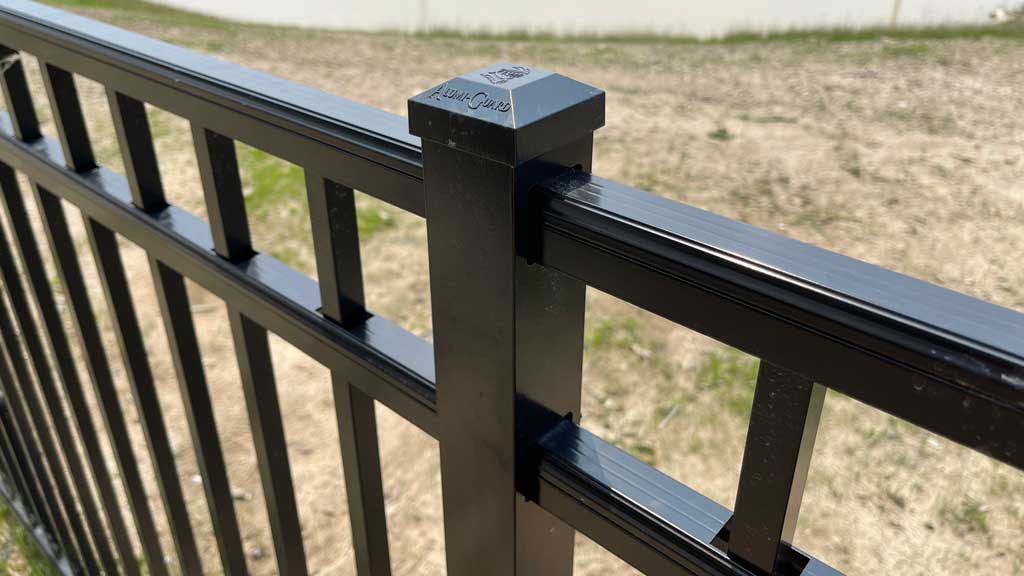
The most common method. Aluminum fence with routed posts are constructed using the post / section method. Meaning you build the fence as you go.
Because of the how the rails get inserted into the posts, it is nearly impossible to set the posts first and insert the rails at a later time. There isn’t enough space to do so.
As a result, when installed correctly, you get a secure fence where sections cannot be removed easily. This is the easiest method to install aluminum fence.
Using the section as a guide as to where to dig the next hole. Once the first post is dug and set in concrete, the rails of a section are inserted into the post and secured with self tapping screws. The next hole gets dug at the end of the section and the process repeats.
Posts Straps or Brackets
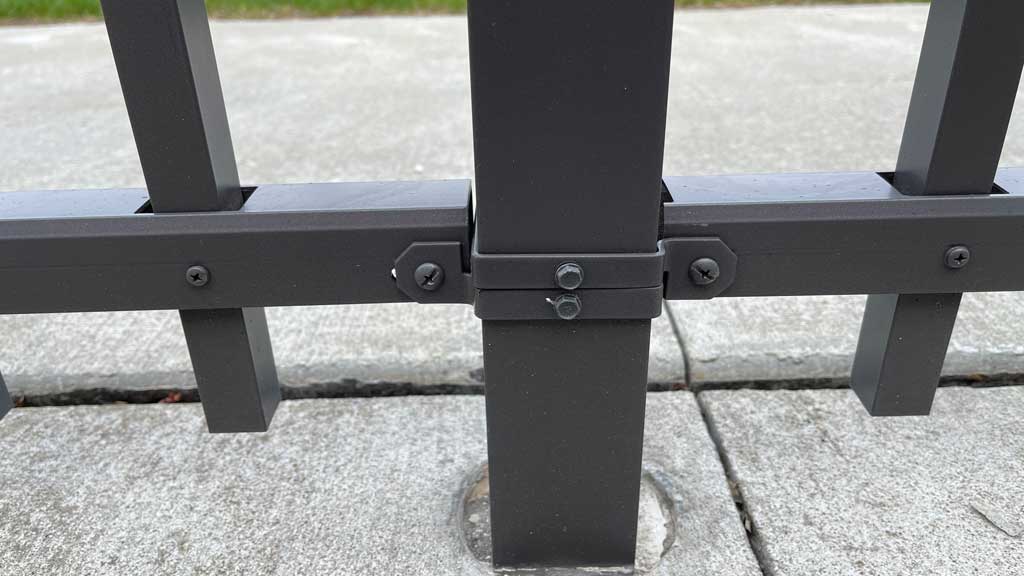
The second method to attaching aluminum fence sections to the posts is using a strap or bracket. When installing using this method, all of the posts can be set first.
Making sure they have the correct measurement in between or on center is of the utmost importance. Too small, and you’ll have to trim the length of your section. Too big and the section won’t be long enough.
The advantage to installing aluminum fence in this manner is that once the sections are attached with the brackets, you can adjust the height of the fence before installing the finial set screws.
Another advantage is if you should ever need access and don’t have a gate large enough, you can remove a section easily at a later date.
Conclusion
Aluminum fence is one of the most popular options you can choose today. Adding an elegant and classy look to your yard.
It will remain beautiful due to being maintenance free. It is unobtrusive to neighbors, and HOA’s love it.
If you don’t need a privacy fence, aluminum is the way to go if you can afford it. It will last forever or will be a great selling point if you ever decide to sell your home.
With countless color, style, and height combinations, aluminum fence is sure to fit your needs.
If you completed this guide, you are now armed with the information to make an educated purchase on an aluminum fence. Enjoy!
For a more affordable fence option, checkout our chain link fence guide!!!

